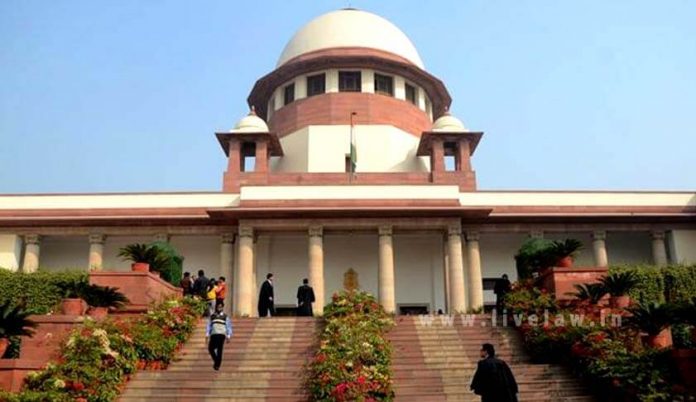This article is written by R Sai Gayatri, from the Post Graduate College of Law, Osmania University. This article talks in detail about the e-committee established by the Supreme Court of India and its achievements.
Table of Contents
Introduction
In furtherance of a proposal put forward by the Supreme Court of India, an e-committee has been constituted. It is a body that functions under the aegis of the Government of India. The e-committee is supposed to assist in the formulation of a national policy that shall focus on computerising the judiciary of the country. The e-committee is also supposed to advise upon the changes regarding managerial and technological aspects. Let us know more about this e-committee.
The Supreme Court e-committee
The Supreme Court e-committee looks after the e-Courts project that has been developed along with the National Information Center (NIC) and the Department of Judiciary. The e-Courts concept was engineered under the National Policy and Action Plan for Implementation of Information and Communication Technology (ICT) in the Indian Judiciary of 2005.
The said e-committee facilitated a guide for the usage of Information Technology (IT) and administrative changes that took place in the Indian Judiciary. The e-committee was constituted in 2004. The committee aimed at improving the Indian Judiciary by involving a technological angle to approach the legal system.
The e-committee of the Supreme Court of India has its Patron-in-Chief as Justice Sharad Arvind Bobde – Chief Justice of India, Chairperson as Justice DY Chandrachud – Judge, Supreme Court of India and Vice-Chairperson as Justice R.C. Chavan – Former Judge, Bombay High Court, and four other members.
Functions of the digital platforms of the e-committee
- To track the details and status of any particular case pending in any Indian court.
- To manage the matters pending before various courts in the country.
- To enable quick categorisation of cases based on the database information.
- To utilize the resources of the court efficiently.
- To keep a check on the performance of the judiciary by analysing the data.
Role of e-committee in empowering young lawyers
In the words of Justice DY Chandrachud “technology has been extraordinarily enabling and empowering for young lawyers”. The various digital interfaces developed by the e-committee have empowered the lawyers, litigants, other law departments, and the common man to obtain judicial information/data whenever needed. As the technological approach to the courts is much faster than the traditional approach, the complex procedures of the courts shall not be delayed. As technology has more of an inclusive approach towards justice, it enables lawyers to reduce the gap between clients and the courts.
Amidst the lockdown due to Coronavirus, the e-courts have played a key role in delivering justice seamlessly. The whole nation was under lockdown, but the courts of the country never took a break from doing their job. The legal fraternity, though divided by the lockdown, was united by technology, thanks to the e-committee that developed e-Courts and many other such interfaces. This is a solid example of how the e-committee is encouraging young lawyers to become legal heroes and a strong means for people to acquire justice as they deserve.
E-committee and speedy delivery of justice: a complementary element
Around 3.65 crore cases are pending in India. Judicial productivity is one of the main concerns of the Indian judiciary and the e-committee is playing a significant role in increasing such productivity. Affordability and timely justice for all is the end goal of the Indian Judiciary but due to the abundant cases which pose a burden on it, achieving speedy delivery of justice by just employing traditional court methods seems to be a distant dream. This is where the e-committee and its e-Courts come into play. With the help of information technology, achieving justice does not just become quick but also affordable.
Principles of the e-committee
- Justice must be easily accessible by all – It is the right of every citizen of India to have access to justice. They must be given an equal opportunity to be heard. The e-committee also abides by the same and tries to eradicate the socio-economic difficulties faced by people while trying to access justice with the help of technology.
- Use of technology to transform – As per the committee’s ideology, technology must not merely reform the traditional methods into modern ones but it should as well transform the approach towards justice by empowering citizens with reliable means.
- Eradication of the tardy judicial system – With the help of technology, the performance of the judiciary is set to improve as it results in affordable and speedy delivery of justice.
Objectives of the e-committee
- To increase judicial productivity in both quantitative and qualitative means.
- To connect all the courts of the country by interlinking them.
- To enable the Indian Judiciary with Information and Communication Technology (ICT).
- To develop a transparent, easy to access, reliable, and affordable justice system.
Phase II objectives of the e-committee
- To provide information regarding a case using the web portal, short message service, mobile application, e-mail, and kiosks to the litigants.
- Providing case management to the Judicial officers with caseload management.
- Making a completely planned schedule for the lawyers.
- To provide facilities to the High Court Judges and the District Judges for monitoring and supervising purposes.
- To formulate plans for the improvement of the judiciary systematically.
- To provide state-wide supervision and monitoring of cases in every District and Taluka by the Department of Justice, High Courts, Researchers, and other Academics.
An overview of the achievements of the Supreme Court e-committee
The e-committee of the Supreme Court through the means of e-Courts has garnered the following achievements:
- Developed the largest Free and Open Source Software (FOSS) based case information and management system in the world.
- Adoption of the Free Open Source Software-based platform resulted in estimated savings of Rupees 340 crores to the country excluding the recurrent costs towards license fees and maintenance.
- Online data of 3256 court complexes across the country has been made available.
- Established individual websites of 688 district courts in the country.
- Created a common Case Management and Information System software, known as “CIS National Core v3.2” software for all the district as well as the subordinate courts in the country.
- Case Management and Information system software known as “CIS National Core v1.0” has been implemented in all the twenty-two High Courts of India.
- The mobile application created by the e-committee witnessed around 4.54 million downloads by Android users.
- Data of 13.60 crore pending and disposed cases from District and Taluka courts has been uploaded to the National Judicial Data Grid (NJDG).
- The pending cases (3.38 crore), orders (12.49 crore), and judgments of various High Courts have been made available online.
The e-committee also bagged the following awards:
- Gems of Digital India Award 2018 – the e-committee secured this award for its e-Courts project. The award was presented by the Ministry of Information Technology, Government of India for excellence in e-governance.
- Digital India – Best Mobile App Award 2018 – the services of the e-Courts Project developed by the e-committee received the Platinum Award for Best Mobile App.
The Supreme Court e-committee: a portrayal of good use of available technology
Technology has always been considered as a medium that is taking the human-kind toward greater strides of advancement. It is considered a harbinger in the legal sector as well. The insufficiency of lawyers and judges led to a huge number of pending cases in the country. The abundance of volumes and documents regarding every single case makes the judicial process even more sluggish, the result however is a delayed justice delivery system. It can also be said that the lack of proper technological implementation in the legal industry might be one of the key reasons that have burdened the Indian Judiciary.
The legal industry and technology must work in sync with each other to establish an efficient and expeditious judicial system in India. For example, the Supreme Court e-committee has conceptualized the e-Courts project which has eased the approach for justice to an extent, this can be considered as a good start to achieving the goal of establishing a responsive judiciary in the country. Harnessing the technology as per the needs of the legal industry must be one of the main objectives of present generation lawyers.
It is a known fact that the internet is easily available in almost all parts of the country. If the information regarding a particular case is available online, then it would be a simple task for the lawyers and clients to acquire such data. It also reduces delays in the court process and avoids redundancy. Through the establishment of e-Courts under the e-committee, one can witness that the judiciary has put a step forward towards being a transparent, easy to access, and reliable legal system. The e-Courts eliminate the use of unscrupulous methods involved in the legal system and increase time efficiency.
Almost all of us have noticed in the lockdown period that the proceedings took place through video conferencing. This method has proven to help tackle the issue of being unable to record evidence due to the absence of witnesses in the court. Video conferencing also helps to eradicate the problem of a witness being scared off from the court by a party of influence. It can be said that through technology the court itself goes to the people it is concerned with.
With the help of technology, lawyers can proceed with their filing from the comfort of their office/residence. Unlike the conventional methods, he may simply create a docket sheet, and whenever the documents are filed, he can update the details. It is a herculean task to manage the smooth functioning of work in courts, but with new software technology, case management has become easier which results in a systematic performance of the courts.
Humans may commit mistakes but technology rarely messes up with its efficiency and accuracy. Technology has made it a cakewalk for all the advocates, clerks, and other related workers to record and store the data of any particular case that they might be dealing with. The chance that the files may get mixed up, changed, or damaged is negligible.
Legal services in India have gone through a rigorous transformation due to the presence of technology. Services relating to contracts, wills, leases, consumer complaints, etc are being attended to online and with proper lawyer guidance. Such online legal service platforms create a link between potential clients and lawyers creating a win-win situation for both of them. The client gets a good lawyer who specializes in the required subject and the lawyer gets a clientele for himself.
The e-Courts have proven to cut the costs incurred by the Indian Judiciary and simultaneously save its time. It is a wise decision to establish e-Courts all over India to provide expeditious and affordable solutions to all the people involved in the Indian legal system. Since the information will be easily available online, the government must make sure that strong security systems are employed for the protection of such data.
The fact that the lawyers of the present generation are trying their best to inculcate the usage of technology into their legal practice is promising. The traditional methods employed in the Indian legal system are one of the main reasons creating a heavy burden on the Indian Judiciary. Now that the Supreme Court through its e-committee has given a break to such a conventional approach towards law, it is established that technology is being put to good use for the betterment of the legal industry.
Conclusion
Hence, the Supreme Court e-committee is a boon to the Indian legal system as it is a step towards making India a ‘legal-tech based nation. Encouraging the use of technology not only enhances the legal system but also empowers young lawyers to endeavor towards establishing a technology-driven legal fraternity. It is high time that we recognize that the legal system of our country needs a technological transformation and it must be done from the basics. The e-committee is a baby step towards such transformation. The moment we stop being sceptical about combining law and technology and start making changes in the traditional approach towards law is the moment we make the Indian legal system a technology-driven one.
References
- https://ecommitteesci.gov.in/
- https://www.bloombergquint.com/law-and-policy/supreme-court-launches-new-e-committee-website
- https://scroll.in/latest/962838/despite-public-health-crisis-it-is-courts-duty-to-protect-rights-of-citizens-justice-chandrachud
- https://www.cnbc.com/2020/02/06/technology-is-changing-the-legal-profession-and-law-schools.html
- https://www.thehindubusinessline.com/news/technology-can-speed-up-delivery-of-justice-nr-narayana-murthy/article25750522.ece
- https://pib.gov.in/Pressreleaseshare.aspx?PRID=1684770
LawSikho has created a telegram group for exchanging legal knowledge, referrals, and various opportunities. You can click on this link and join:
 Serato DJ Crack 2025Serato DJ PRO Crack
Serato DJ Crack 2025Serato DJ PRO Crack











 Allow notifications
Allow notifications



